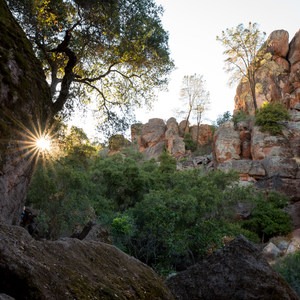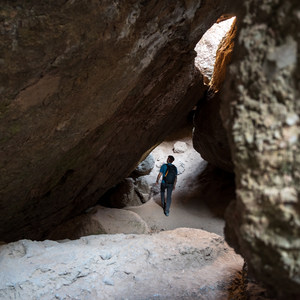You are here
Pinnacles climbing is adventure climbing, and the High Peaks are the heart of the Pinnacles National Park. With seemingly innumerable rock formations and routes on them, the High Peaks can almost overwhelm the new Pinns climber with choice. Brad Young's "Climber's Guide to Pinnacles National Monument" is the quintessential local guidebook with detailed approach maps and route topos. It is highly recommended for anyone looking to explore Pinnacles climbing and the High Peaks in particular.
Access is via the High Peaks Trail out of Bear Gulch on the east side of the park or the Juniper Canyon Trail on the west side. Either approach is a stout uphill few miles with no protection from the blazing sun on hot days or biting wind on cold ones. Bring snacks and enough water for a full day of strenuous activity in addition to sunscreen and appropriate clothing.
High peaks climbs are a mix of bolted routes and traditional routes. Some classics include:
Photographer's Delight (5.4 PG13)
Condor Condiment (5.8 four pitches)
Little Javelina (5.9)
Burgundy Dome - Rappel Route (5.7)
Feather Canyon (5.8 alpine-style eight pitches)
Pinnacles National Park is the newest national park in the United States, acquiring this status in 2013 after being originally established as a national monument by Theodore Roosevelt in 1908. The park features dramatic volcanic rock formations including high peaks, caves, and highly-featured walls that are well suited to rock climbing. The peaks rising above the surrounding farms and grasslands host one of the highest densities of prairie falcons in North America as well as reintroduced California condors and a growing population of peregrine falcons. Other wildlife include coyote, bobcat, California quail, golden eagle, and cougar. The High Peaks are generally the most likely location to spot the famous California condors.
Rock climbing has a long history in Pinnacles, which has seen first ascents throughout the development of the sport in the United States from the 1930s through modern times. The local climbing community has a strict ground-up bolting policy forbidding bolting on rappel. Resulting sport climbs have a natural flow but do not always offer convenient protection on crux moves. Though the volcanic rock is not as robust as the granite found in Yosemite and the Sierra Nevada, numerous mineral crystals and other features make for routes that often give climbers many sequencing choices. These crystals are prone to being dislodged, however, so both climbers and belayers in Pinnacles should always wear helmets. Experienced Pinnacles climbers try to avoid using the crystals as often as possible, instead looking for grip in the rock between the knobs.








Comments
Sign In and share them.